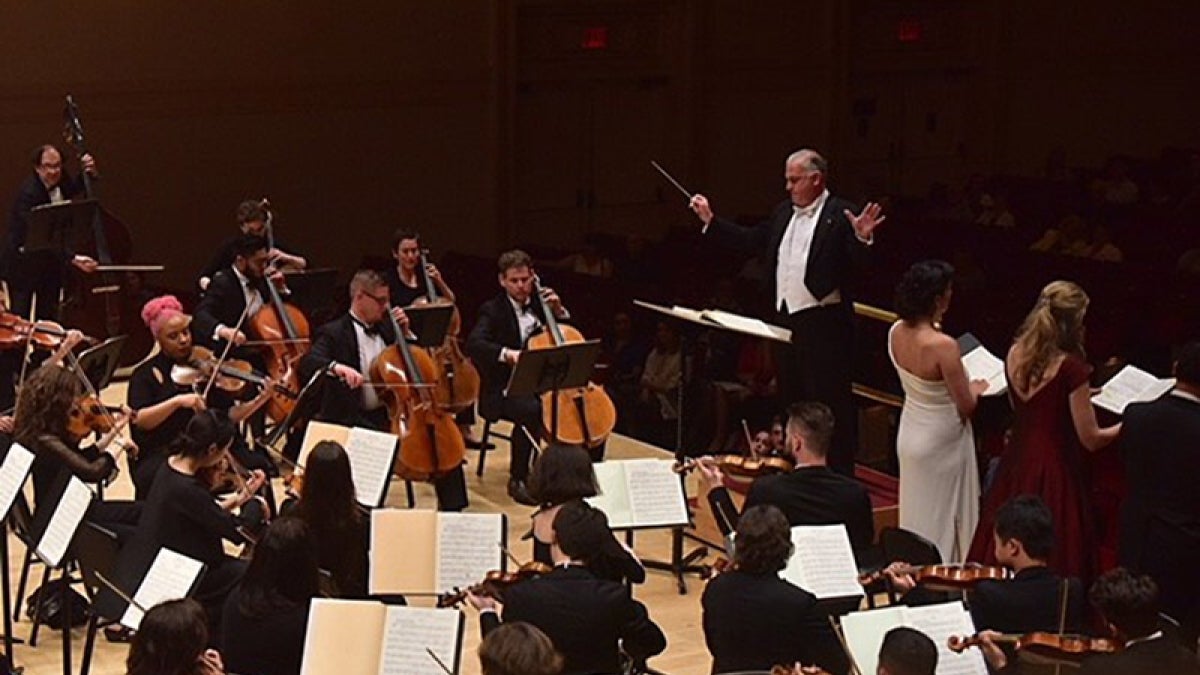ASU choral members bond and grow with performance at Carnegie Hall

David Schildkret, director of choral activities in the ASU School of Music, conducting choral students at Carnegie Hall.
Imagine traveling to an exciting destination, singing in a world-famous concert hall and acquiring a true understanding of a composer’s music, all while building a deep sense of community.
This past June, under the direction of David Schildkret, director of choral activities at the ASU School of Music, approximately 80 members of ASU’s choral program did just that on a trip that culminated in a performance at Carnegie Hall.
“Choral music really does come out of a feeling of community,” Schildkret said. “The more the singers enjoy being with each other and relate to one another, the better the music is.”
Schildkret was invited to assemble a group of singers and conduct the Beethoven Mass in C Major at Carnegie Hall in New York City. The 120-voice choir consisted of 80 singers drawn from each of the ASU choral program’s seven ensembles along with ASU alumni. The remaining singers included at least one person from every place Schildkret has ever worked, dating back to the 1980s when he was a faculty member at the University of Rochester. The Carnegie Hall choir also featured 30 students from the American International School, a charter high school in Murray, Utah. The high school students were recommended by Erica Glenn, an ASU choral conducting doctoral student who had previously taught at the school.
“There is something very special that happens when people travel together — a wonderful kind of bonding experience,” Schildkret said.
The majority of ASU singers came from the ASU Choral Union, the choir with the longest history at Arizona State University. Founded in the 1950s, the choir is Phoenix’s oldest symphonic choir, performing regularly with the ASU Symphony Orchestra and other ensembles. The choral program at ASU’s School of Music in the Herberger Institute for Design and the Arts presently involves more than 400 students, faculty, staff and community members. The various choirs welcome members at all skill levels to participate.
Throughout the 2018 spring semester, ASU choir members rehearsed weekly for the Carnegie Hall performance, which reprised a presentation of the Beethoven performed at ASU Gammage in April 2017. Choir members who participated paid their own travel expenses.
The Carnegie Hall program involved four conductors each conducting a work of 30 minutes with an assembled choir, professional soloists and a professional instrumental ensemble called the New England Symphonic Orchestra. The Beethoven performance received a standing ovation.
Schildkret said the experience of being somewhere else to perform — in a different place, on a different stage, with a different audience — also contributed to the value of the experience.
“It was transfixing,” Schildkret said, “to perform in this legendary concert hall — the place to perform. It’s a very warm and beautiful late 19th-century building with all its American nouveau riche elegance. The appearance and acoustics of the hall are incomparable. And it’s in the heart of New York City near Lincoln Center.” Many of the choir members were visiting New York for the first time.
Schildkret said that the Carnegie Hall performance allowed choir members the opportunity to perform the complicated Beethoven Mass in C Major again, having done it the year before, to learn more about the music as well as to approach the work on a deeper level. It also allowed the singers to connect to a new audience and expand the scope of its community.
Schildkret pointed out that there are three components essential to making a complete musical experience — a composer, a performer and a listener as an active participant.
“But I believe that it’s really the audience that is the true artist,” Schildkret said. “The composer and performers are not actually making art, even though we think we are. We provide the stimulus to the audience’s imagination, and they are the ones actually creating the art. And it’s that shared experience of creativity among the composer, the performers and the audience that generates the ultimate sense of community.”

